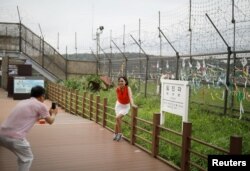South Koreans are buying more gold and ready-to-eat meals, while the government plans to expand nationwide civil defense drills planned for this month as rhetoric between North Korea and the United States ramps up tension.
Long used to living within the range of North Korea’s artillery, people in the South have generally ignored its aggressiveness and series of nuclear and long-range missile tests.
But this week, as Pyongyang exchanged increasingly angry words with the United States, there are worries of a clash erupting along the heavily militarized frontier, which divides the two Koreas.
Ready to eat meals
Combat Ration Inc, which makes 2 billion won ($1.75 million) of annual revenue selling ready to eat meals, said sales had surged as much as 50 percent in the past week compared to the average.
“Since 2006, when North Korea first conducted its nuclear test, there wasn’t this much response as people became immune to frequent missile launches and nuclear tests,” said Yoon Hee-yeul, the chief executive of Combat Ration, based in the southeastern city of Daegu.
“I feel it’s different this time,” said Yoon, who’s been in the business since 2004.
Ready to eat meals maker Babmart, based in eastern Seoul, and another Seoul-based online seller, jun2food.com, also said sales have increased. Officials at both companies attributed the surge to the heightened tension.
Gold purchases rise
Song Jong-gil, an official of Korea Gold Exchange 3M, said the same tensions are behind a five-fold surge in sales of mini gold bars since Aug. 9.
After U.S. President Donald Trump’s “fire and fury” threat heightened tension, the average daily sales volume has been 250 bars, ranging in weight between 10 grams (0.35 oz) and 100 grams (3.5 oz), versus about 50 bars earlier, Song said, adding the trend would continue through August.
Investors widely consider gold a safe-haven asset at times of growing geopolitical risk or economic uncertainty. South Koreans, who are still technically at war with their combative neighbors, are no exception.
Experts say if North Korea did launch intermediate-range missiles toward Guam, all its other missiles and artillery would be ready as well. Hundreds of thousands of troops and huge arsenals are arrayed on both sides of the demilitarized zone between the two Koreas.
At least 1,000 of the North’s artillery pieces are capable of reaching densely populated Seoul and its metropolitan area, home to some 25 million people.
Civil defense drills
Seoul is expanding its participation in a nationwide civil defense drill, set to take place Aug. 23, Shim Kang-cheon, a local Seoul government official, told Reuters.
The five-minute drill begins with a siren on the radio, and cars are stopped at designated spots. Pedestrians are escorted off the streets and taken to safe places like subway stations.
All of Seoul’s 25 districts will participate in the drill this year, Shim said, compared to just five last year.
The drill coincides with the four-day “Ulji Freedom Guardian” military maneuvers Aug. 21-24, which are held yearly and include joint exercises by the U.S. and South Korean armed forces, as well as drills for emergencies.
But many officials say there is a long way to go to raise public awareness about civil defense. At two subway stations visited by Reuters Friday, many people didn’t know they were among Seoul’s more than 3,200 designated bomb shelters.
Few bomb shelters have long-term supplies of food, water, medical kits or gas masks, because the mostly private owners of the shelters get no public funding.











